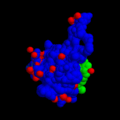Salmon Vampires and Birds.....
NOAA Teacher at Sea: Natalie Macke
NOAA Ship: Oscar Dyson Mission: BASIS Survey
Geographical area of cruise: Bering Sea Date: 9/2/2010
NOAA Ship: Oscar Dyson Mission: BASIS Survey
Geographical area of cruise: Bering Sea Date: 9/2/2010
Weather Data from the Bridge :
Visibility : 10+ nautical miles (Wondering what a nautical mile is??)
Wind Direction: From the SE at 12 knots
Sea wave height: 2-3ft Swell wave direction: 3-4 ft NW
Sea temp:9.9 oC Sea level pressure: 1014.4 mb Air temp: 11.2oC
Science and Technology Log:
NOAA Fish Biologist Brian Beckman is our resident salmon vampire aboard the Oscar Dyson. He's been diligently collecting salmon blood samples anytime we catch them. So I finally got a chance near the end of our journey to sit down and talk with Brian about why he want all those samples...Insulin-like Growth Factor One (IGF1)
This is a ubiquitous protein that is made in the liver which causes calls to divide and grow. So simply put, it causes growth. Since the level of IGF1 in the blood is relatively stable, scientists can infer the growth rate of a fish by analyzing for this protein in the blood samples. The growth rate is not an absolute value, but instead a relative comparison between fish populations. Brian has been studying IGF1 levels in salmon off the coast of Oregon and is now trying to extrapolate or compare his findings with the salmon in the Bering Sea. When averaging his finding over the region of coastal Oregon, he has been successful in correlating IGF1 levels in salmon with overall zooplankton abundance in the region.
More food --> healthier juvenile salmon --> higher levels of IGF1 --> greater abundance of adult salmon
Getting a Bit more technical..
 |
| IGF1 |
Brian also is concerned about the age of his salmon specimens. Since bigger fish will be producing a steroid that stimulates the production of IGF1. Therefore, bigger fish's IGF1 levels are a consequence of both the effect of the steroid and the fish's diet. So, by collecting juvenile fish (no steroid production yet) a direct comparison can be made between the fish's diet and it's growth rate.
Birding on the Oscar Dyson
So on Thursday it was apparent to the crew and scientists that our fishing was done. Troubles with the winch made balancing an open net in the water impossible. Since our perfect 20 days of weather had us ahead of schedule, our sampling stations for this leg of the BASIS cruise were completed and our job was now done. The scientists could now rest a bit and enjoy their cruise back to Dutch Harbor. Except for two..... our colleagues from the Alaska Fish and Wildlife Service. Tamara Zeller and Aaron Lang are aboard this cruise, not for fish or oceanographic samples; but instead they are here to perform an opportunistic survey about seabirds. Armed only with a computer, binoculars and their savvy for visual details they collect data only when the ship is cruising so this last sprint to the harbor meant it was time for them to do some birding.
The computer pings and Tamara records what she sees from her window on the front starboard side of the bridge. Indicators of ocean health, the Fish and Wildlife Service collects baseline data on seabird distribution and abundance in the Bering Sea. Since most seabirds only come to land to breed, when ships like the Oscar Dyson has room aboard, a bird observer will take advantage of the opportunity to collect some data.
When I asked Aaron and Tamara what the most exciting bird this trip was, they had a hard time deciding between the two shown below.
 |
| Tamara, Bruce, Aaron and Jeanette (left to right) |
When I asked Aaron and Tamara what the most exciting bird this trip was, they had a hard time deciding between the two shown below.
|
|
Personal Log
The ending to our cruise on the Oscar Dyson will be bitter sweet. While I'm happy to be on land again, I will certainly miss the camaraderie of all aboard the ship. I could not have wished for a better group of people and a more professional crew. Everyone went to extraordinary measures to help me understand all they do AND how they do it. A special thanks to Ed Farley, our Chief Scientist and Jeanette Gann, my bunkmate and friend these past twenty days.. I wonder how many morning I'll awake dreaming about collecting water samples from Niskin bottles??
Everyone on board and the NOAA crew was amazingly helpful and patient with the paparazzi teacher. I'll miss you all and thank you all once again...
Over and out..

































